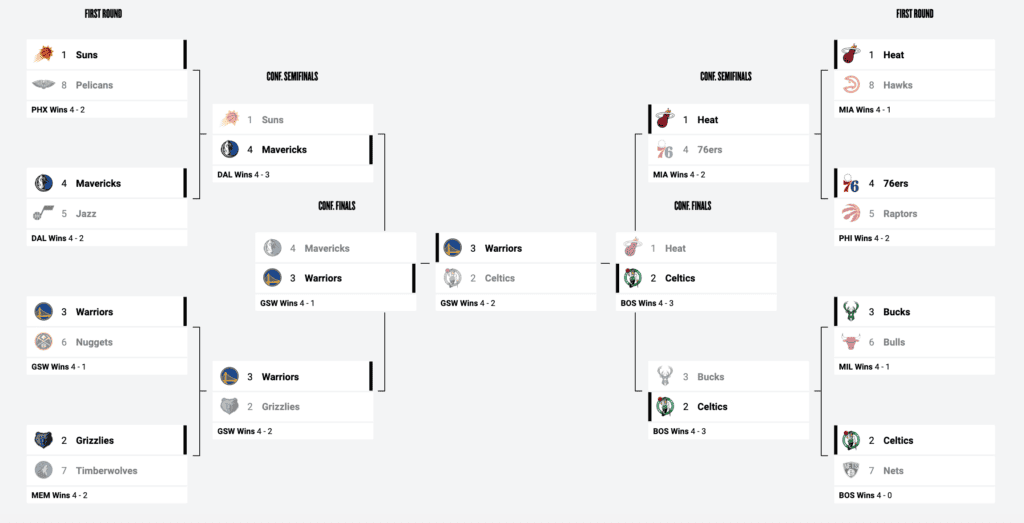Within the context of sports, seeding refers to the numerical ranking of a team or player as they head into a tournament. With NBA seeding specifically, we’re looking at a teams rank within their conference as they head into the NBA finals. At the moment, that rank is based mostly on a teams win percentage in the regular season.
But this is sports, so things can’t quite be that simple and elegant. In this post, we’ll delve into the intricacies of NBA seeding, exploring the details of its purpose, impact, strategies, controversies, and the evolving nature of the NBA seeding system.
Let’s break it down…
How NBA seeding works
The league consists of two conferences: the Eastern Conference and the Western Conference. Each conference has three divisions. Teams compete against each other through 83 games in the regular season to secure a playoff berth. The eight top-seeded teams from each conference qualify for the playoffs.
NBA Seeding is determined by a combination of factors and the details are regularly adjusted from season to season. You can find what are apparently the current official guidelines for seed determination here.
Here’s the basic explanation…
Teams are first ranked based on their win-loss records. If two or more teams have the same regular season win/loss record, we go to the tie breaker rules.
The division leader tie-breaker
If one of the tied teams is the leader in their division, they take the higher seed. This effectively guarantees division winners a top-4 seeding.
The head-to-head record tie-breaker
The first tie-breaker is . We looking specifically at the games those tied teams have played against each other. And again, the team with the highest win/loss record takes the higher seed.
The division record tie-breaker
If the tied teams are in the same division, the team with the better record against teams in their division gets the higher seed.
The finals contender record tie-breaker
The team with the better win percentage against the other teams eligible for the playoffs in their conference gets the higher seed. This includes teams that finished the regular season tied for a playoff position.
The total points tie-breaker
The team with the best point differential gets the higher seed. Take every game played and subtract total points allowed from total points made.
What is the purpose of NBA seeding?
Imagine you’re headed into the NBA finals. You’ve worked hard in the regular season to not only get a spot in the playoffs, but to maintain a winning record.
To get that title, you now have to win 16 games against 4 different teams. The question of which teams you play and where and when you play them is going to have a massive influence on your chances of making it through.
If we don’t have a fair and transparent process for handing out matchups, there will be complaints. The solution is to let a teams regular season performance determine their finals matchup.
The teams that win the most games in the regular season gets to play the teams in the finals that have won the least. On top of that, they get home court advantage, meaning that the first 2 games, as well as games 5 and 7 if they occur, will be played on the court belonging o the higher seeded team.
So the main value of NBA seeding is that it helps to provide a clear framework for deciding finals matchups.
Advantages of a higher seed in the NBA playoffs
A higher seed in the playoffs gets you several advantages.
First of all, and maybe most importantly, you get home-court advantage. This means that you’re probably playing more games overall on your own court.
You’re in front of your fans, using your own training facilities, and probably sleeping in your own bed. The value of home-court advantage can vary by team.
Stats consistently prove that all teams perform better at home. to put it in terms of points, home court looks to be worth 2-5 points on average.
The edge is most dramatic with the Jazz and the Nuggets. This is probably due mostly to the altitude. Even for professional athletes, that restricted oxygen level will slow you down.
An additional benefit of a higher NBA seeding is that you face lower-seeded opponents in the early rounds. Check out the bracket from the 2022 finals.

In the first round, the 1-seed faces the 8-seed, the 2-seed faces the 7-seed, and so on. The result is theoretically an easier path to the title for the higher seeded teams.
The Suns just had to get through the 8-seed and the 4-seed to get to the WCF. They didn’t do that, because they’re the Suns, but theoretically it should have been easier than the Warriors grinding through the 6-seed and the 2-seed.
There can also be a tangible psychological benefit. A higher seed can give you a confidence boost. Just the knowledge that you’re the better team can reinforce a winning mindset.
Historical moments related to NBA seeding
The history of the NBA playoffs is filled with remarkable stories influenced by seeding. Several underdog teams have defied expectation and made deep playoff runs despite a low seeding.
2023 Miami Heat
In the 2023 NBA finals, the Miami Heat squeaked in as an 8-seed. They were actually a 7-seed leading up to the playoffs, but they lost their first play-in game to the Atlanta Hawks.
Led by a HOF coach in Eric Spoelstra and an incredible and tenacious performance from small forward Jimmy Butler, the Heat were able to edge out the Milwaukee Bucks (favored by many to win the title) in just 5 games.
1995 Houston Rockets
With a 47-35 record, the Houston Rockets entered the first round of the 1995 NBA finals as a 6-seed. They beat Utah, Phoenix, and San Antonio to meet the Eastern Conference Champion Orlando Magic in the final series.
They swept the magic. None of the teams they faced had fewer than 50 wins that regular season.
This is a great story and you can find a more complete rundown over here.
1999 New York Knicks
The Knicks had a terrible 98-99 season, narrowly sliding into the playoffs as an 8-seed. Early elimination was looking very likely. With that, coach Jeff Van Gundy would likely be sent packing as well.
They picked it up in the playoffs and made it through the 1-seed Heat, coasting through the Hawks, and the Pacers. They ultimately fell in the finals to San Antonio.
The evolution of NBA seeding
While seeding has its merits, it has faced criticisms. Notably, the discrepancy in the competitiveness of conferences has led to debates about whether the seeding system should be re-worked.
One conference may be significantly stronger than the other. This can cause superior teams to end up with lower seeds than their counterparts in an opposing conference.
There have been proposals, discussions, and several significant modifications to seeding rules in the NBA’s history, intended to further improve transparency and fairness.
The play-in tournament
The play-in started in 2020 as a response to the Covid-shortened season. Teams would now have to compete for those final seeds in the playoffs.
Initially, if the 8 and 9 seeds in either conference were within four games of each other, they would meet for a play-in game. If the 8-seed won, it would advance to the playoffs. If the 9-seed won, a second game would be played. If the 9-seed could win both games, they could advance to the playoffs.
The format was enough of a success that the concept was brought back for the 2020-2021 season. This time, however, the 7-10 seeds would compete in a ‘play-in tournament’ for the 7th and 8th seeds in the playoff bracket.
With the play-in tournament, the 2 higher seeds (in this case the 7 and 8) compete for the chance to secure their playoff run with the 7-seed. The 2 lower-seeded teams (the 9 and the 10 seeds) compete for a chance to play the loser of that first game and secure the 8-seed.
This format is known as the Page-McIntyre system. Page-McIntyre originates with Australian football in the 1930’s. This format has remained through the 2023 season.
NBA seeding prior to 2004
Before 2004, the two conferences were divided into only two divisions each. The rules at the time guaranteed that the top two seeds would be awarded to the winners of each division.
This meant that the top two teams in a conference would never meet until the conference finals, if at all. But it also meant the top two teams in a conference may not, in fact, be the top two teams.
For example, in 2003, the Sacramento Kings with a 59-22 record claimed the 2-seed over the Mavericks with a 60-22 record. The Kings had a weaker record, but they had won their division.
NBA seeding 2004-2006
In 2004, the NBA expanded to 30 teams with the Charlotte Bobcats. With 30 teams, it made sense to realign to 3 divisions per conference, each including 5 teams.
Seeding rules adjusted to the new system, guaranteeing the top 3 seeds to the 3 division champs. This meant created the possibility that the team with the 2nd best record in the conference could end up at the 4-seed. It also meant that the best teams in the conference could end up meeting in the conference semifinals instead of the conference finals.
In the 2006 finals, this happened. The conference leaders, the San Antonio Spurs and the Dallas Mavericks, met in the conference semifinals. And the people did not rejoice.
NBA seeding post 2006
With the fallout from the 2006 matchup debacle, it was obvious there had to be a change.
In the 2006 post-season, the league announced officially that it would shift the seeding format for the 06-07 season. The leaders in the conference would be seeded according to win-loss record. This removed the possibility that the the 2 top teams could meet before the conference finals, barring a repeat of that 2006 flub.
Takeaways
Seeding in the NBA plays an important role in laying the path to the NBA finals. The NBA continues to evolve and adapt its seeding system to enhance both fairness and competitiveness.
Without NBA seeding, the basketball world would be total anarchy. We’d have teams just rolling out of bed expecting to play the worst team in the league and walk out with the title. We’d have freak occurrences like Jimmy Butler taking an 8-seed team to the finals.
